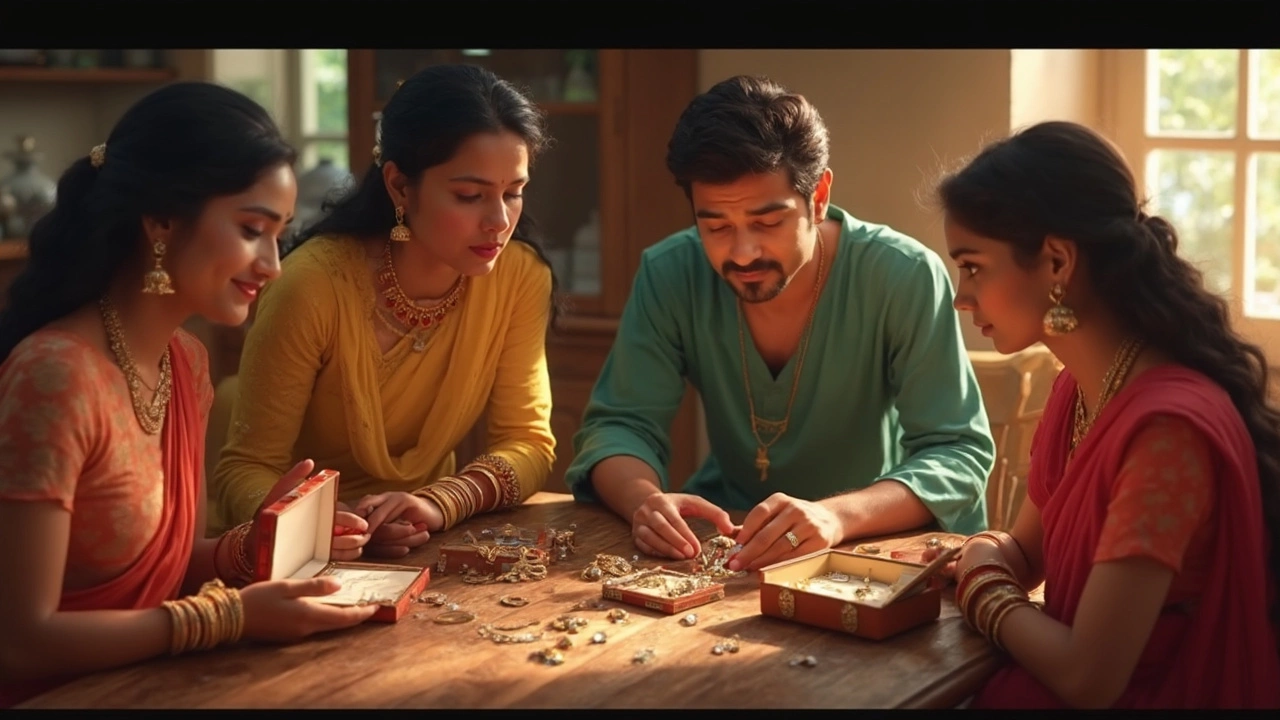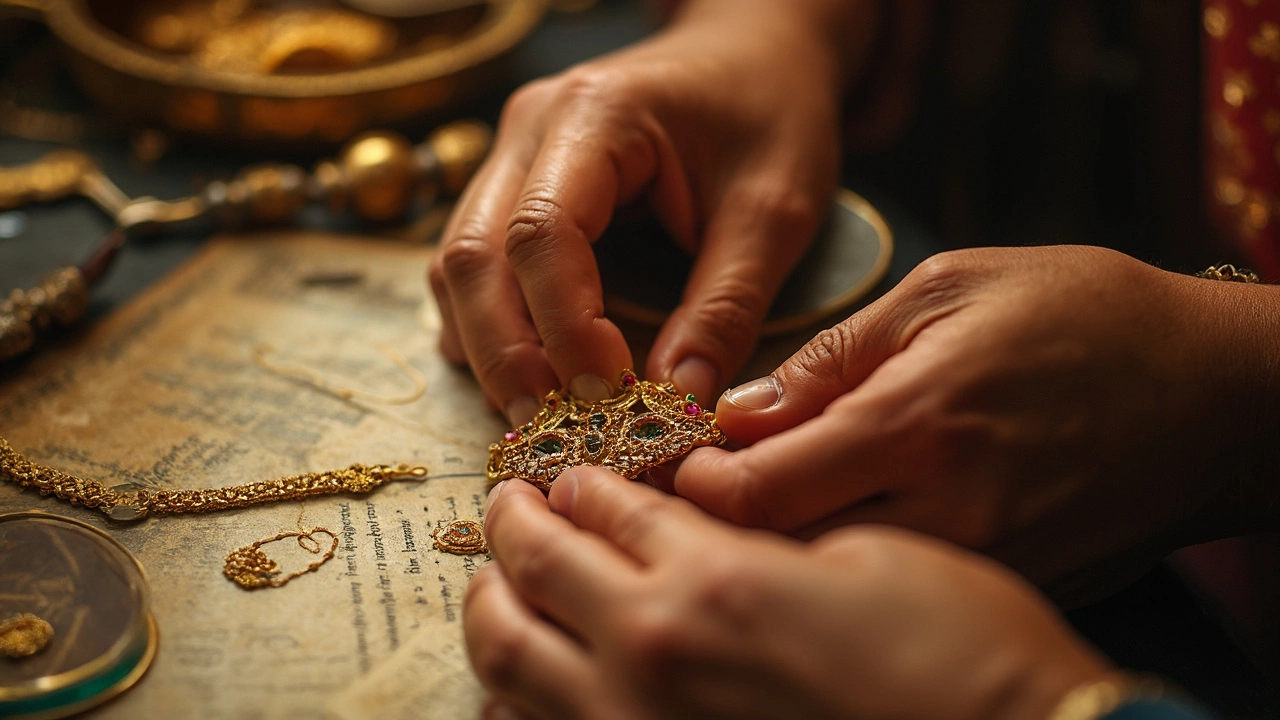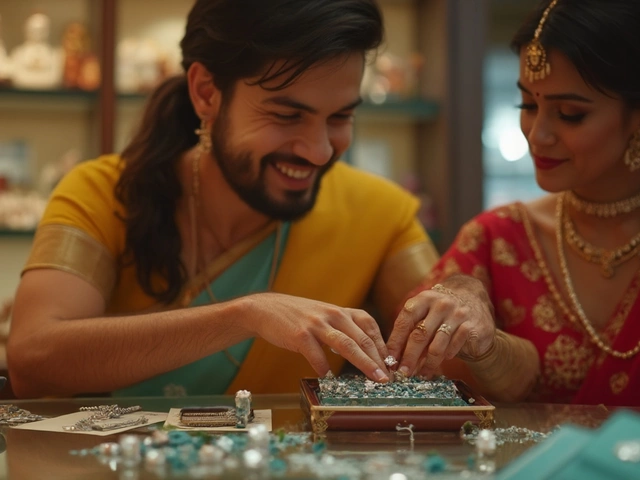
If you’ve ever stared at your grandma’s old ring and wondered if it’s worth a fortune or just sentimental value, you’re not alone. Figuring out what your antique jewelry is truly worth isn’t as simple as looking it up online or guessing by how shiny it looks.
Start by taking a close look at the piece. Does it have any stamps or marks on the inside or clasp? These little engravings, called hallmarks or maker’s marks, can tell you a ton about when and where it was made. Some rare marks mean big bucks, while others are more common. Grab a magnifying glass or take a super-close photo if you can’t see them clearly with your eyes.
Pay attention to the materials. Genuine gold, silver, or platinum pieces will often feel heavier than costume jewelry. And antique jewelry often features tiny, old-school details like hand-cut stones or intricate metalwork. If you’re not sure, a simple magnet test can rule out fake metals (real gold and silver won’t stick to a magnet at all).
- Spotting Signs of Value in Antique Jewelry
- Checking for Hallmarks and Maker’s Marks
- When to Trust Online Valuations (And When Not To)
- Getting a Professional Appraisal: What to Expect
Spotting Signs of Value in Antique Jewelry
Not every old earring or brooch is a hidden treasure, but there are tried-and-true ways to spot jewelry that’s actually worth something. Knowledge is your best tool here—people often toss or give away valuable pieces without realizing it. Here’s what to watch for:
- Materials Matter: Real gold, platinum, and silver hold value. If you spot '14K', '18K', 'PLAT', or '925' stamped somewhere, you might be in luck. Good antique pieces rarely use cheap metals.
- Hand-Crafted Details: Look for things that look unusual or imperfect, like slightly uneven patterns or tiny handmade settings. Machine-perfect jewelry usually means it’s newer.
- Gemstones: Stones with odd shapes or little nicks and uneven cuts can hint at hand-cut, old stones—these are big pointers toward real vintage. Modern stones are more uniform.
- Maker's Marks: Unique logos, initials, or names often mean you’ve got a piece by a known designer or brand. Some famous names like Tiffany & Co. or Cartier can add thousands to the value.
- Weight: Heavy pieces often mean real metal. Lightweight jewelry tends to be cheaper in both age and value.
If you’re not sure about what you’ve found, write down or photograph any marks. Search them online or show them to a jeweler. Still, don’t trust just any quick online answer.
Here’s something else—knowing the age of the jewelry helps. Antique usually means over 100 years old, while vintage is around 20-99 years. The rarer and older the piece, the more valuable it can be.
| Characteristic | Why It Matters |
|---|---|
| Hallmarks | Prove metal purity and sometimes location/year |
| Maker's Mark | Adds value if the maker is famous |
| Hand-cut Stones | Older cutting methods, rare today |
| Patina | Natural tarnish—shows age, not dirt |
| Construction Style | Hand-soldering or early clasps/hinges suggest age |
Don’t just judge by looks. That dusty brooch in your drawer could turn out to be a rare Victorian piece. The trick is knowing what to spot, and taking the time to check each detail.
Checking for Hallmarks and Maker’s Marks
If you want to figure out the jewelry appraisal game, your best friend is going to be hallmarks and maker’s marks. These tiny stamps are the jewelry world’s way of cutting through the guesswork. They tell you what your piece is made out of, where it came from, and sometimes even who made it. Sounds pretty basic, but it’s amazing how often people overlook these clues.
Here’s how to spot them: take off your ring, necklace, or brooch and check the inside, back, or clasp. Use your phone camera or a magnifying glass, because some marks are seriously tiny. What you’re looking for:
- Purity marks like “925” for sterling silver, “375”, “585”, “750” for different karats of gold, or “PLAT” for platinum.
- Country marks, like a lion for British sterling silver or an eagle’s head for French gold.
- Maker’s marks, which are often initials or tiny symbols (like Tiffany & Co. or Cartier). Sometimes, these make all the difference, especially with antique or vintage jewelry.
- Date letters and other symbols, mostly on British pieces, which can point you to the exact year of creation.
Some marks are worth more than others, and certain symbols were only used for a short time. For example, British hallmarking has been around for over 700 years, and a single letter can completely change what a piece is worth.
Here’s a quick cheat sheet of common hallmarks you might bump into:
| Metal | Common Hallmarks | Country Origin Examples |
|---|---|---|
| Gold | 375 (9K), 585 (14K), 750 (18K) | UK, Italy, USA |
| Silver | 925 (Sterling), Lion Passant | UK, Germany, USA |
| Platinum | PLAT, 950 | USA, France |
If you can’t find any marks, don’t panic—very old pieces and custom jewelry sometimes go unmarked, especially before the mid-1800s. But if you find a weird or unfamiliar symbol, there are heaps of online databases where you can look them up for free. Real life tip: double-check for fakes or recent stamps on modern costume pieces pretending to be antique. It’s pretty common, so if your ‘Victorian’ brooch looks brand new and shiny, tread carefully.

When to Trust Online Valuations (And When Not To)
Putting your hopes in online valuations can be a quick way to get an idea, but don’t let flashy websites fool you. Online tools can only work with the information you give them. If you leave out details by accident—or don’t even know all the right things to look for—you’ll get a number that could be way off. Sites like eBay’s sold listings or Ruby Lane give you ballpark numbers for pieces that look like yours, but remember, looks are just one piece of the puzzle with jewelry appraisal.
For basic silver or gold jewelry, prices on trustworthy auction or resale sites can be somewhat close to reality. For antique jewelry, though, value can swing wildly depending on maker, age, condition, and unusual details. One ring might sell for $100; another that looks almost identical could go for ten times that just because it’s from a famous designer.
- Trust online valuations when: You want a rough idea for common metals and non-rare stones, especially if you find sold listings of pieces almost exactly like yours (remember to check actual selling prices, not the “for sale” price!)
- Don’t trust them when: Your jewelry is antique, features rare gemstones or weird marks, or could be from a known designer. Things like sentimental or historical value aren’t captured in basic web forms. Also, beware of any site that wants to "buy now" on your first click or asks for a fee up front.
For a better sense of how much online values can shift, here’s a quick snapshot of price ranges found on auction sites for vintage rings in 2024:
| Type | Low Sale Price (USD) | High Sale Price (USD) |
|---|---|---|
| Simple 14k gold band | $90 | $250 |
| Victorian-era diamond ring | $500 | $6,000 |
| Signed Art Deco piece | $800 | $15,000 |
| Unbranded costume cocktail ring | $10 | $60 |
So, take online valuations as a starting point—but never as the final word, especially for anything old or unusual. Still not sure? Some auction houses and trusted jewelry forums will give you a quick opinion for free, if you post clear, well-lit photos of the piece and any stamps or marks. But when real money’s at stake, there’s nothing better than in-person advice from someone who does this for a living.
Getting a Professional Appraisal: What to Expect
If you want a number you can trust, nothing beats having a professional appraiser check out your jewelry. A real appraisal does way more than just guess at what something "might" be worth. Here’s how it works and what you should know before walking in.
First, look for an appraiser with solid credentials. People certified by the Gemological Institute of America (GIA), the American Gem Society (AGS), or the National Association of Jewelry Appraisers (NAJA) have rigorous training and follow honest standards. Don’t just take your jewelry anywhere—the pawn shop guy may not know antique pieces at all.
Once you set up your appointment, the appraiser usually does all this right in front of you:
- Carefully checks your jewelry for hallmarks, signs of handcrafting, and age.
- Measures and tests the metals and stones (sometimes with cool gadgets that can spot fakes instantly).
- Makes notes about condition, style, and unique traits. Tiny chips or repairs can change value a lot—don’t try to hide anything, just be upfront.
- Compares your piece to real sales data from shops and auctions, not just random internet listings.
Most appraisals take about 30 to 60 minutes per piece, but complicated items could need more time. You’ll get a written report with pictures, lab results (if stones were tested), and clear price estimates for different situations (like insurance or resale).
Here’s what you might pay for a typical jewelry appraisal in the U.S. right now:
| Type of Item | Typical Appraisal Cost |
|---|---|
| Simple ring or chain | $50 - $100 |
| Fancy antique brooch, multi-gem piece | $100 - $250 |
| High-value or complex estate jewelry | $200 - $500+ |
Some jewelers offer free value "estimates," but those aren’t detailed appraisals—they’re often just for trade-in offers and won’t work for insurance or legal paperwork. Always ask what you’re getting.
After your report, it’s smart to re-appraise valuable items every three to five years. Market prices for gold, diamonds, and vintage styles change way more than most folks think.




